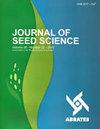近红外光谱和幼苗图像分析评价卧斑尿藻种子的生理潜能
IF 1.2
4区 农林科学
Q3 AGRONOMY
引用次数: 0
摘要
摘要:对快速、准确评估种子生理潜能技术的需求使得近红外光谱(FT-NIR)和ILASTIK软件的幼苗分析成为有前途的工具。本研究利用近红外光谱(FT-NIR)和ILASTIK软件对脱赤尿藻种子的生理潜能进行了评价。通过对10批玉米种子的生理电位(发芽和活力)进行分类,获得种子样品的FT-NIR光谱,并对原始光谱进行不同色散校正,利用偏最小二乘判别分析(PSL-DA)构建分类模型。在ILASTIK评估中,在幼苗萌发的第7天和第14天拍摄幼苗,并将训练好的分类器应用于图像,生成强幼苗、弱幼苗和未发芽种子的数量数据。利用经Savitzky-Golay二阶导数预处理的FT-NIR技术数据,可以得到一种基于种子生理势的高效分类模型。ILASTIK仅在萌发7天后就能有效地根据种子的生理势进行分类。FT-NIR和ILASTIK分析是非破坏性和快速的替代方法,具有很大的潜力来控制美国的种子批次。本文章由计算机程序翻译,如有差异,请以英文原文为准。
Near infrared spectroscopy and seedling image analysis to evaluate the physiological potential of Urochloa decumbens (Stapf) R.D. Webster seeds
Abstract: The demand for techniques that make it possible to assess the physiological potential of seeds quickly and assertively make near-infrared spectroscopy (FT-NIR) and seedling analysis using ILASTIK software promising tools. The aim of this study was to evaluate the physiological potential of Urochloa decumbens seeds using near-infrared spectroscopy (FT-NIR) and ILASTIK software. Seeds from 10 lots of U. decumbens were classified according to their physiological potential (germination and vigor) and then FT-NIR spectra were obtained from individual seed samples, the original spectra being pre-processed with different dispersion correction methods used for the construction of a classification model through partial least squares discriminant analysis (PSL-DA). For the ILASTIK evaluation, the seedlings were photographed at 7 and 14 days of germination and the trained classifier was applied to the images, generating data on the numbers of strong seedlings, weak seedlings and non-germinated seeds. With data from the FT-NIR technique pre-processed by the 2nd derivative of Savitzky-Golay, it was possible to obtain a classification model with high efficiency to discriminate the classes regarding the physiological potential of the seeds. ILASTIK was efficient to classify seeds according to their physiological potential after only 7 days of germination. FT-NIR and ILASTIK analyses are non-destructive and fast alternatives, with great potential for quality control of U. decumbens seed lots.
求助全文
通过发布文献求助,成功后即可免费获取论文全文。
去求助
来源期刊

Journal of Seed Science
Agricultural and Biological Sciences-Agronomy and Crop Science
CiteScore
2.00
自引率
30.00%
发文量
28
审稿时长
12 weeks
期刊介绍:
From 2017 the Journal of Seed Science (JSS) will circulate online version only.
Original scientific studies and communications, not yet published or submitted to another journal for publication and written in Portuguese or English, will be accepted for publication. For manuscripts submitted in English, the authors should provide an adequated version.
The SCIENTIFIC COMMUNICATION is a category of scientific manuscript which describes a technique, an equipment, new species or observations and surveys of limited results. It has the same scientific rigor as the “Scientific Articles” and the same value as a publication. The classification of a manuscript as a SCIENTIFIC COMMUNICATION is based on its content and scientific merit but it can be a preliminary study, simple and not definitive on a certain subject, with publication justified by its uniqueness and contribution to the area.
The Editorial Board of the JSS may invite leading authors of recognized reputation to compose specific Review Articles covering topics of their specialization that will convey to the scientific community the state-of-the-art knowledge related to the specific theme.
 求助内容:
求助内容: 应助结果提醒方式:
应助结果提醒方式:


